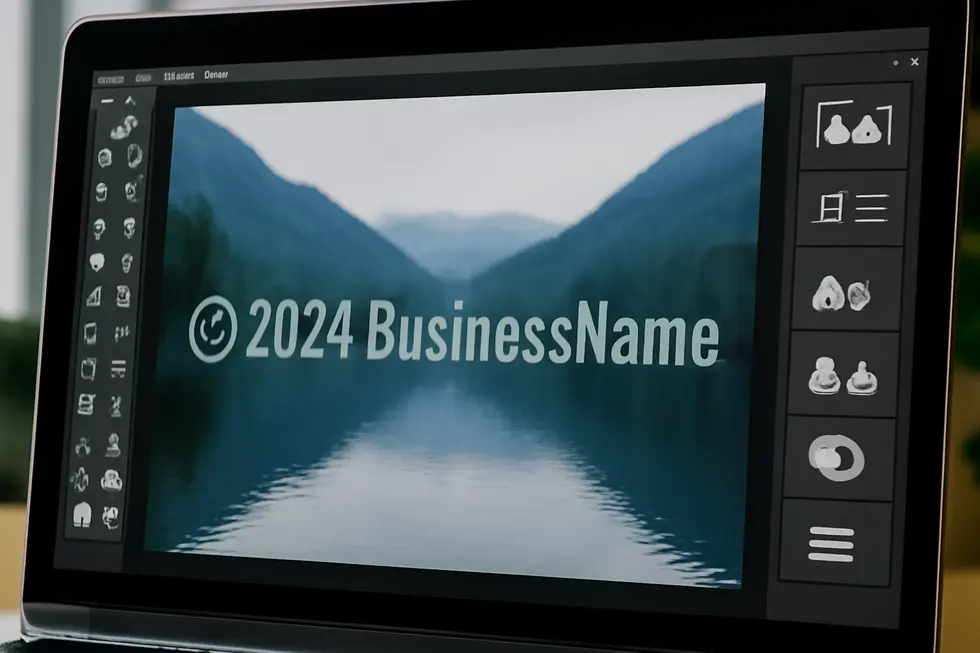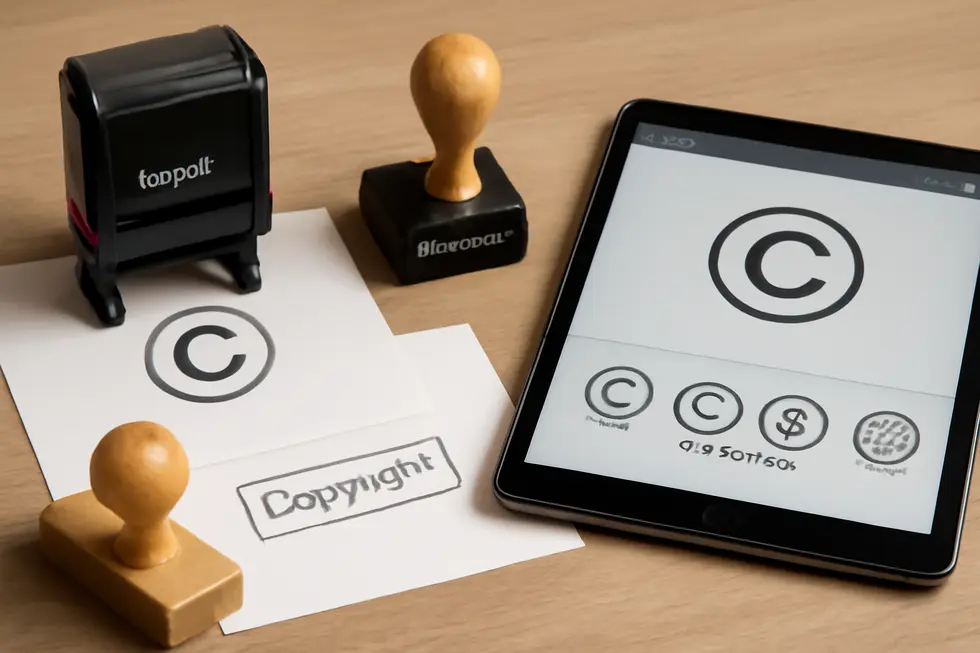Introduction
Copyright ownership has become increasingly vital for business owners as intellectual property forms the foundation of brand identity and revenue. A copyright stamp, whether digital or physical, acts as a visible marker that asserts your rights and deters unauthorized use of your creative works. Understanding the different forms of copyright stamps and their implementation ensures that your assets remain protected both online and offline. This guide unveils essential aspects of copyright stamps: from digital watermarking tools and practical applications to physical stamp options, and key brands that specialize in creating reliable copyright marks. Each chapter builds a comprehensive understanding so you can confidently protect your business’s creative content in every format.
Tables of Contents
Chapter 1: Digital Copyright Stamp: Tools and Applications for Online Content Protection
- Harnessing Technology: Software and Solutions Empowering Digital Copyright Stamping
- Navigating the Economic, Legal, and Societal Impact of Digital Copyright Stamping
Chapter 2: Physical Copyright Stamp: Custom Rubber and Metal Stamps for Tangible Media
- Crafting Precision and Durability: The Design and Manufacturing Journey of Physical Copyright Stamps
- The Role and Value of Custom Rubber and Metal Stamps in Branding and Copyright Enforcement for Physical Works
Chapter 3: Technical and Practical Aspects of Implementing Copyright Stamps
- Harnessing Watermarking, Blockchain, and Digital Fingerprinting for Robust Copyright Protection
- Mastering Practical Implementation: Ownership Marking, Documentation, and Legal Compliance in Copyright Stamping
Chapter 4: Brands and Services Specializing in Copyright Stamp Creation and Usage
- Comprehensive Legal and Strategic Support Integral to Copyright Stamp Protection
- Navigating the Market: Leading Providers Bridging Legal Protection and Practical Branding for Copyright Stamps
Chapter 1: Digital Copyright Stamp: Tools and Applications for Online Content Protection

1. Harnessing Technology: Software and Solutions Empowering Digital Copyright Stamping
The realm of digital copyright stamping relies heavily on advanced technological tools and software solutions to ensure effective online content protection. These tools extend beyond simple visible marks to incorporate robust mechanisms safeguarding digital assets from unauthorized use and infringement.
Central to digital copyright stamping are watermark and stamp maker applications. These versatile apps allow creators to generate customized digital stamps, combining text, logos, and copyright symbols with color and placement options. Such customization ensures that each watermark is unique and professionally tailored, making it clear to viewers that the content is legally protected. Many of these applications support batch processing, enabling efficient handling of large image collections and applying consistent copyright marks rapidly. This ease of branding and protection plays a vital role for photographers, digital artists, and publishers who regularly distribute visual content across multiple platforms.
Beyond watermarking, some platforms offer digital rubber stamp creators that merge the traditional aesthetics of stamped marks with the agility and flexibility of digital workflows. This fusion allows for quick insertion of copyright indicators in documents and images without needing physical stamps, offering a seamless approach to digital documentation and content authenticity.
Yet, visual marking alone is insufficient to combat all forms of digital infringement. Digital Rights Management (DRM) technologies complement copyright stamps by embedding invisible security layers within digital files. These technologies effectively restrict unauthorized copying, sharing, or editing of protected media, adding a crucial barrier against piracy. Unlike visible watermarks, DRM actively enforces access control and usage rules, directly limiting how content can be duplicated or disseminated online. This technological safeguard is indispensable for creators and businesses seeking long-term protection of their intellectual property.
Furthermore, digital copyright protection is strengthened by legal frameworks that work alongside technological tools. The Digital Millennium Copyright Act (DMCA), for instance, facilitates the rapid removal of infringing content from online platforms. This legal recourse empowers content owners to uphold their rights swiftly and decisively, creating a comprehensive ecosystem where software solutions and legal measures intertwine.
Together, these technologies form a multi-layered defense strategy, combining visible copyright stamps, watermarking, DRM, and enforceable legal processes to secure digital content. This integrated approach enhances a creator’s ability to assert ownership, deter infringement, and pursue claims if violations occur. For more insight into how content protection technologies collaborate with legal protections, explore the copyright language for business owners.
By leveraging this blend of innovative applications and enforcement measures, creators maintain control over their digital assets, preserving the value and integrity of their work amidst the complexities of the online environment.
External resource for further reading and application examples: https://apps.microsoft.com/detail/9p7z3tgx6568?hl=en-US
2. Navigating the Economic, Legal, and Societal Impact of Digital Copyright Stamping
Digital copyright stamps have become essential instruments in the ongoing effort to protect online creative content across multiple dimensions—economic, legal, and societal. Economically, these stamps serve as a deterrent to unauthorized use and piracy, which worldwide account for significant revenue losses in creative industries. By embedding visible or hidden markers such as watermarks and metadata, creators signal ownership clearly, making it harder for infringers to exploit intellectual property without consequence. This visible assertion not only preserves creators’ income streams but also supports the sustainability of digital content creation by reducing the ease and appeal of piracy.
Legally, the combination of digital copyright stamps with formal copyright registration greatly bolsters enforcement capabilities. While copyright automatically exists at creation, registering with authorities adds robust benefits including eligibility for statutory damages and coverage of legal fees when pursuing infringement claims. Digital stamps, especially when blended with cryptographically secure digital signatures and forensic metadata, provide admissible evidence in legal disputes. Furthermore, the Digital Millennium Copyright Act (DMCA) offers a procedural pathway for quick removal of infringing materials from online platforms through takedown notices, streamlining rights enforcement for content owners. The advent of AI-powered monitoring tools amplifies this legal framework by scanning vast volumes of web content in real time, detecting unauthorized usage efficiently and minimizing wrongful claims by evaluating contextual factors such as fair use.
On a societal level, digital copyright stamps help maintain the integrity and credibility of creative works on the internet. They ensure creators receive proper attribution and discourage misuse that can lead to defamation or distortion of original materials. This protection cultivates a culture of respect and ethical sharing, where content creators’ intentions are honored and the spread of misleading or harmful alterations is curtailed. As such, copyright stamps contribute to preserving trustworthiness in digital communications and artistic expression.
The integration of these economic, legal, and societal benefits reflects a comprehensive approach. Tools like visible and invisible watermarking, metadata embedding, digital signatures, and AI-enhanced infringement detection form a multilayered defense supporting creators’ rights. Coupled with established legal mechanisms including copyright registration and DMCA enforcement, digital copyright stamps equip content owners with practical methods to assert and defend ownership in the fluid online environment. This synergy between technology and legal measures addresses many challenges faced by creators seeking to protect intellectual property amid the vast and dynamic digital ecosystem.
For a deeper understanding of how digital copyright protections intersect with business strategies and legal frameworks, explore detailed guidance on copyright language and its role in business.
Additional insights and practical guidance on watermarking and official registration can be found in comprehensive resources such as Fotober’s photo protection guide.
Chapter 2: Physical Copyright Stamp: Custom Rubber and Metal Stamps for Tangible Media

1. Crafting Precision and Durability: The Design and Manufacturing Journey of Physical Copyright Stamps
The creation of physical copyright stamps—whether rubber or metal—entails a meticulous design and manufacturing process that balances artistic detail with practical durability. These stamps serve as tangible marks of ownership, imprinting copyright symbols, logos, or other identifying marks onto materials ranging from paper to wood and fabric. Their role is pivotal in asserting copyright presence beyond digital media, ensuring ownership claims are clearly visible on physical works.
The design phase begins with generating a precise graphic representation of the desired copyright emblem. Often, this involves creating a high-resolution vector image that faithfully reproduces every curve and detail of logos or text required. This graphic foundation is critical for the manufacturing process, as it determines how sharply the final stamp will transfer the design onto various surfaces.
Once the design is finalized, the next step is to produce the stamp plate. For rubber stamps, this often involves laser engraving a rubber sheet based on the vector image, using precision machinery to carve the design with fine detail. Alternatively, photopolymer techniques may be employed where light-sensitive materials harden to form raised areas corresponding to the design, enabling clean and consistent impressions. In rubber stamps, the engraved or molded rubber is then mounted on a wooden block that provides ergonomic handling, while also ensuring stability when pressing the stamp onto surfaces. The blocks vary in shape and size to accommodate different stamping needs and volumes.
Metal stamps, frequently referred to as embossing seals, take a different manufacturing path involving the machining of hardened steel dies. The design is etched or engraved onto these dies with exceptional precision to create a relief that, under pressure, embosses the design onto materials such as paper. This technique leaves a raised, tactile imprint often used for official documents or certifications where ink application is not desirable. The durability of metal stamps usually surpasses rubber counterparts, making them suitable for repeated use in professional settings.
These manufacturing methods—laser engraving for rubber stamps and die-making for metal stamps—require close collaboration between graphic designers and skilled technicians. The result is a stamp that not only replicates complex logos or copyright marks with high fidelity but also withstands frequent use across various physical media. Sizes can range from small seals to wide-format stamps exceeding thirty centimeters to fit diverse applications.
Beyond the physical product, it’s important to recognize that these stamps involve multiple layers of intellectual property protection. While the copyright safeguards the artistic design of logos and layouts incorporated into the stamp, patents may be relevant if unique mechanical features exist in the stamp’s construction or usage. Trademark law protects distinct branding elements included in the stamped imprint, reinforcing legal ownership of the brand identity visible on the physical media. Understanding these distinctions helps stamp users protect their rights effectively and reinforces the stamp’s role as a legal assertion of copyright.
For those interested in deeper legal insight surrounding copyright and branding protections, resources like trademark2go’s guide on trademark protection for business names and logos offer valuable information.
This synthesis of creative design, advanced manufacturing, and legal awareness culminates in physical stamps that uphold copyright claims with durable, precise markings. Such stamps remain indispensable tools for creators and businesses seeking tangible evidence of ownership across their physical products and media.
2. The Role and Value of Custom Rubber and Metal Stamps in Branding and Copyright Enforcement for Physical Works
Custom rubber and metal stamps provide a practical and powerful method for creators and businesses to visibly assert copyright ownership on physical media. Unlike digital protections, these physical stamps physically imprint copyright symbols, logos, or trademarks directly onto tangible products, such as books, artworks, certificates, and packaging. This action serves multiple critical functions — it not only marks ownership clearly, reinforcing legal rights, but simultaneously strengthens brand identity through consistent visual elements.
When a physical copyright stamp is applied, it leaves an unmistakable sign that the work is protected by law. This visible declaration helps deter unauthorized use or reproduction by signaling to potential infringers that the content is legally safeguarded. Such deterrence is particularly valuable for small businesses, independent artists, and limited-run product creators who may lack access to more complex or costly copyright protection methods. The relatively low cost and ease of use of these stamps make them an accessible tool to enforce rights without the need for advanced printing or embossing technologies.
Beyond legal concerns, the branding impact of these stamps is significant. Incorporating custom logos or trademarks into the stamp design transforms a copyright mark into a branding asset. This consistent placement ties ownership claims directly to the creator’s identity or company, encouraging customer recognition and enhancing trust in the product’s authenticity. When consumers see a familiar logo or symbol stamped on a physical item, it helps build the brand’s reputation over time. This linkage between copyright marking and brand reinforcement is an essential advantage of physical stamping.
In intellectual property disputes, a stamped physical mark often acts as tangible evidence of ownership and originality. Having the copyright information immutably imprinted onto a work can simplify legal processes and support claims by firmly establishing the date and source of the material. Moreover, these stamps complement registered trademarks that legally protect brand names and logos but do not themselves mark individual physical products. Physical copyright stamps therefore bridge the gap between legal registration and practical, everyday protection.
Although digital watermarking is increasingly common for online media, physical copyright stamps retain vital relevance for traditional products requiring tactile authenticity. Their reusability and durability empower small-scale producers to maintain thorough copyright assertion efficiently. Environmental considerations have also influenced manufacturers to produce eco-friendly stamping options, allowing conscientious businesses to align ethical practices with legal protections.
For further guidance on protecting your brand and copyright interests, resources on federal trademark registration offer valuable insights on integrating trademarks within physical marking strategies. (See, for example, USPTO’s trademark basics and registration process.)
This balanced approach of combining copyright protection and brand identity through custom stamps ensures that creators maintain control over their physical works while cultivating consumer recognition and trust. The simplicity, cost-effectiveness, and legal strength of physical copyright stamps make them indispensable for tangible media creators seeking authentic and enforceable ownership marks.
For those interested in a deeper exploration of trademark and copyright intersectional strategies, consider reviewing comprehensive intellectual property protection guidance tailored for businesses at trademark2go.com/trademark-protection-business-name-logo/.
Chapter 3: Technical and Practical Aspects of Implementing Copyright Stamps

1. Harnessing Watermarking, Blockchain, and Digital Fingerprinting for Robust Copyright Protection
Implementing copyright stamps in the digital age involves a sophisticated blend of watermarking, blockchain, and digital fingerprinting technologies that together reinforce the protection of intellectual property. Watermarking serves as the foundational layer, embedding visible or invisible indicators directly into digital content such as images, videos, and audio files. Visible watermarks act as a straightforward deterrent by displaying clear copyright information, instantly signaling ownership to viewers and discouraging unauthorized use. Behind the scenes, invisible watermarks—often enhanced by artificial intelligence—embed covert identifiers that endure common manipulations like compression or cropping. This forensic approach allows rights holders to trace unauthorized copies back to their source, even when content is altered, although it does not inherently block copying itself.
Blockchain technology complements watermarking by providing a decentralized, immutable ledger where ownership details and provenance can be securely registered. Creators timestamp their works or convert them into non-fungible tokens (NFTs) recorded on the blockchain, establishing a public, tamper-proof proof of creation. Smart contracts embedded within these blockchain systems automate rights management, facilitating automatic licensing, royalty distribution, and even micro-payments as content is accessed or used. While blockchain ensures transparent proof and management of ownership, it does not physically prevent unauthorized copying but instead supports enforcement and verification processes.
Digital fingerprinting, or perceptual hashing, further strengthens protection by generating unique, content-derived identifiers for media files. These fingerprints capture intrinsic characteristics of the content, enabling efficient detection of unauthorized copies or altered versions at scale. When integrated with blockchain, fingerprint data can be immutably stored to substantiate ownership claims and trigger automated infringement alerts. This synergy allows for scalable monitoring across vast digital ecosystems without the need for visible marks.
Together, these approaches form a complementary ecosystem where watermarking visibly marks content, fingerprinting uniquely identifies it, and blockchain secures its ownership. Practical implementations deploy backend APIs and smart contracts alongside user authentication tools to create transparent and secure registration, verification, and licensing frameworks. This integration significantly improves the reliability of copyright assertion, helping creators track, manage, and enforce their rights across digital channels. Nevertheless, this technical triad focuses on detection and proof rather than outright prevention of copying.
For a detailed example of such an integrated system, consider blockchain frameworks that combine perceptual hashing with smart contracts to establish video copyright protection on platforms like Ethereum. These systems showcase how linking fingerprinting and blockchain can deliver tamper-proof ownership records and infringement detection mechanisms that operate in real time. To explore more about the role of blockchain in media protection and copyright stamping, comprehensive technical guides offer valuable insights into these cutting-edge methodologies.
This technical foundation sets the stage for understanding the broader economic, legal, and societal impact of digital copyright stamps and the practical tools available for online content protection.
2. Mastering Practical Implementation: Ownership Marking, Documentation, and Legal Compliance in Copyright Stamping
Effective implementation of copyright stamps hinges on three intertwined pillars: clear ownership marking, rigorous documentation, and unwavering legal compliance. Each plays a vital role in safeguarding intellectual property and asserting the creator’s rights across media and legal frameworks.
Ownership marking serves as the foundational step, where the copyright stamp—typically comprising the © symbol, the year of creation, and the owner’s name—is visibly integrated into the work. This marking not only signals public notice but also acts as a deterrent against unauthorized use. Strategic placement is paramount; the stamp should occupy a consistent and prominent spot on digital images, printed materials, or physical products to maximize visibility. Compliance with industry or jurisdictional standards ensures that these marks are legally recognized and effective. For instance, digital media often require the stamp to be unobtrusive yet discernible, while printed content might follow specific layout conventions. This visible assertion forms the frontline defense in ownership recognition.
Complementing physical marking is the indispensable process of documentation, which substantiates the ownership claims underpinning the copyright stamp. Maintaining comprehensive records of the original works, creation dates, and, when applicable, official registration certificates is critical. Additionally, storing license agreements and contracts that define ownership and usage rights solidifies the creator’s position. In digital realms, advanced technologies further enhance documentation; perceptual hashing methods generate unique fingerprints of content, while blockchain registration creates immutable timestamps, offering transparent and tamper-proof proof of ownership. These innovations streamline enforcement efforts by providing reliable evidence if infringement disputes arise.
Equally crucial is legal compliance, which dictates that copyright stamps and their application conform to the laws and regulations governing intellectual property in relevant jurisdictions. Correct use of the copyright symbol and precise wording are mandatory to meet legal standards. Moreover, licensing arrangements must be clearly documented and legally sound to prevent potential misuse or conflicts. Some scenarios demand notarization or official validation of stamps, including specific details like expiration dates or titles to ensure legitimacy. Crafting contracts with explicit clauses on ownership and rights allocation is especially important in collaborative projects or when services are outsourced, protecting all parties involved and minimizing litigation risks.
Together, these practices form a cohesive system that empowers creators to protect their works effectively. By combining visible, standardized ownership marking with meticulous documentation and strict adherence to legal mandates, copyright stamps transcend mere symbols to become robust tools of intellectual property defense. Such a comprehensive approach is indispensable for anyone seeking to secure and enforce copyrights in an increasingly complex creative and legal landscape.
For more insights on establishing and protecting copyright ownership through sound documentation and contract strategies, exploring guidance on copyright language and compliance for business owners can be highly instructive.
External resources such as blockchain-based proof of ownership mechanisms and perceptual hashing techniques provide cutting-edge options that enhance security beyond traditional measures: https://pmc.ncbi.nlm.nih.gov/articles/PMC12399541/
Chapter 4: Brands and Services Specializing in Copyright Stamp Creation and Usage

1. Comprehensive Legal and Strategic Support Integral to Copyright Stamp Protection
Brands and services that specialize in creating and managing copyright stamps extend well beyond the mere production of marks or watermarks; they provide a robust framework of legal and strategic services essential for effective intellectual property protection. These services anchor the entire lifecycle of copyright stamps, from their initial registration to enforcement and strategic commercialization.
At the forefront is copyright registration assistance, where clients receive expert guidance to prepare and file registrations with authorized government bodies. This step is crucial, as it secures statutory protections that empower content owners to pursue infringement claims, including eligibility for statutory damages and attorney’s fees. Such counsel also helps maintain compliance with licensing rules and understand fair use, ensuring that copyright stamp users optimize their protections within established legal boundaries.
In parallel, trademark-related services are often integrated due to the frequent overlap between copyright stamps and brand identifiers. This includes clearance searches to confirm uniqueness, filing trademark applications, and navigating office actions or opposition proceedings. Successful trademark registrations consolidate ownership of logos, slogans, or packaging, complementing copyright stamps by fortifying brand identity and exclusive use rights.
Ongoing portfolio management is another critical service, involving audits and appraisals to evaluate the strength and scope of a client’s IP assets. Management includes timely renewals and proactive enforcement strategies to address potential infringements. This may encompass dispute resolutions, litigation support, or customs recordations that block counterfeit imports, thereby preserving the value embedded in copyright stamps and associated trademarks.
Furthermore, a strategic dimension guides clients on how to leverage their IP assets commercially. Expert advisement determines the most effective protection methods and geographic scopes based on market goals. Licensing frameworks and compliance counseling create revenue streams and avoid legal pitfalls. Protection often extends to design rights, securing unique visual elements tied to packaging or product appearances and integrating them into a holistic IP strategy.
Transactional support is indispensable during mergers, acquisitions, or asset sales, ensuring copyright stamps and related IP rights are accurately documented and transferred. When disputes arise, these service providers offer representation in litigation or alternative dispute resolution forums. The combination of legal precision and strategic business insight turns copyright stamps from simple marks into valuable assets that support brand growth and defense.
Typically, these offerings come from specialized intellectual property law firms and legal service agencies known for their deep expertise in copyright and trademark law. Their focus on protecting creative works and branding helps clients maintain a competitive edge in both digital and physical marketplaces.
For those seeking a comprehensive approach to intellectual property management surrounding copyright stamps, including creation, registration, enforcement, and monetization, these combined legal and strategic services form an indispensable foundation. This approach aligns with best practices and evolving market needs, ensuring copyright stamps are not only visibly marked, but legally fortified and strategically optimized.
For further insights on legal aspects related to copyrights in business contexts, see copyright language for business owners.
More detailed professional legal services of this nature are provided by prominent intellectual property law firms that encompass transactional support, enforcement actions, and portfolio management.
2. Navigating the Market: Leading Providers Bridging Legal Protection and Practical Branding for Copyright Stamps
The marketplace for copyright stamp creation and utilization is shaped by a diverse array of providers that bridge legal expertise with practical branding solutions. At its core, this landscape integrates legal service specialists with creative and production-oriented companies, collectively ensuring that copyright ownership is both formally protected and visibly asserted.
Intellectual property law firms serve as foundational players in this ecosystem. These firms offer comprehensive services including copyright registration, licensing, international enforcement, and portfolio management. Their role is critical in crafting strategies that extend far beyond merely stamping works; they provide counsel tailored to securing rights globally and aligning copyright claims within broader brand protection initiatives. Clients from multiple industries such as technology, entertainment, retail, and healthcare often rely on these firms to navigate the complex IP frameworks that govern copyrights and related protections. Engaging with such specialized counsel is highly recommended for businesses seeking thorough legal grounding for their copyright stamps, ensuring that marks used in commerce hold up to legal scrutiny and are enforceable against infringement. This expertise complements core copyright guidance found in resourceful platforms addressing related legal considerations on copyright language for business owners.
Alongside IP law firms, trademark attorneys contribute complementary services that often intersect with copyright protections. While focused on trademark clearance, monitoring, and enforcement, these legal professionals also assist clients in protecting copyrighted materials as part of holistic brand defense. Their involvement is vital when copyright stamps coexist with trademarks, ensuring coordinated rights management and defense strategies. This synergy reduces risks of infringement and supports robust brand identity safeguards.
The rise of online legal service platforms further democratizes access to copyright protection. By streamlining steps such as business formation, compliance, and intellectual property filings, these providers facilitate preliminary copyright-related processes. Though generally less specialized than full-service law firms, they offer valuable efficiencies for startups and small businesses seeking affordable means to begin protecting their intellectual property assets. This layer of service fits well within a broader copyright protection approach, supporting early-stage needs while recognizing the eventual importance of deeper legal guidance.
On the practical application front, print-on-demand and custom branding companies translate legal protections into tangible visibility. Through integrated tools enabling the addition of copyright stamps, logos, and customized markings on products, these businesses help creators incorporate copyright assertions directly onto merchandise and physical goods. This visibility not only reinforces consumer recognition but also establishes a clear public claim of ownership that can deter unauthorized usage. Though not legal service providers, their role in embedding copyright marks into daily commerce is pivotal.
Together, this ecosystem empowers brands to secure, enforce, and practically display copyright ownership via a blend of legal sophistication and creative execution. Whether through comprehensive legal counsel or user-friendly production tools, each element feeds into a cohesive strategy that enhances protection and visibility in both digital and physical realms. For businesses looking to engage providers for copyright stamp needs, evaluating the full spectrum—from legal expertise to branding services—ensures dependable ownership claims that resonate across markets.
More information on strategic intellectual property counseling can be found at Wilson Sonsini’s IP services.
Final thoughts
For business owners, safeguarding intellectual property is not optional—it’s essential. Copyright stamps serve as a clear, visible assertion of ownership, whether applied digitally to online content or physically to tangible materials. By leveraging the versatile tools and services now available, you can integrate copyright marks into your business processes with ease and precision. Understanding both the technical details of implementation and the benefits offered by trusted providers ensures your creative assets are consistently protected. Embracing these strategies strengthens your brand’s security and empowers you to enforce your rights confidently. In a competitive market, a well-implemented copyright stamp is a key ally in defending your business’s originality and value.
Your IP is the foundation of your success – let’s protect it together before it’s too late. We can’t wait to help you turn your ideas into legally secured assets.
About us
undefined



Your point of view caught my eye and was very interesting. Thanks. I have a question for you.